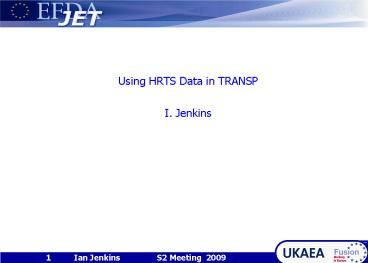Using HRTS Data in TRANSP PowerPoint PPT Presentation
Title: Using HRTS Data in TRANSP
1
- Using HRTS Data in TRANSP
- I. Jenkins
2
HRTS Data in TRANSP I
- HRTS data now routinely available giving much
higher resolution esp. at plasma edge. - However, trajectory of the laser is further from
the plasma midplane data needs remapping before
use in TRANSP (this was not an issue for LIDAR) - Initial attempt used an EFIT equilib. (one time
point) and used FLUSH routines to remap R vector
of HRTS. OK for pulses where equilib. Relatively
stable during period of interest, but still not
using correct equilib. (FLUSH does not work with
TRANSP equilib.)
3
HRTS data in TRANSP II
- Remapping onto TRANSP equilibrium requires
initial run with un-mapped data - This eq. is stored in the .cdf file as a series
of flux contours (normalised poloidal flux) which
can be reconstructed - Then create a 2D (R,z) grid of flux using IDL
function - The (R,z) vector of HRTS data can then be
interpolated onto this grid at each time point - Then re-interpolate onto fine grid which is
constant with time - Write new PPF of re-mapped data
Z (cm)
76063T33 _at_44.718s
R (cm)
4
HRTS data in TRANSP III
- Difference in input data to leads to different
kinetic profiles in TRANSP run - Here T04 (raw data) compared with T42 (fully
re-mapped and smoothed)
5
HRTS in TRANSP IIII
- Comparison of measured Wdia vs TRANSP calculation
After re-mapping
Before re-mapping (T04)
6
Effect on BS Current
- Re-mapping data will have effect on position and
magnitude of Te,Ne gradients effect on
calculated bootstrap current
Te,Ne and CURBS _at_6.0s fot 78085 T02 (raw HRTS)
and T11 (remapped) show the difference in
calculated CURBS (bootstrap profile) When
this is integrated can lead to substantial
difference in total BS current
7
Conclusions
- Re-mapping HRTS data required for TRANSP
- IDL code developed to do this using equilibrium
from initial TRANSP run - Results show improved agreement with measured
Wdia and better match of kinetic/magnetic plasma
edge - Code is available to JET TRANSP runners as
required - Ti re-mapping does not cause such big difference
(not usually strong gradient at edge) but
re-mapping methods are being investigated
PowerShow.com is a leading presentation sharing website. It has millions of presentations already uploaded and available with 1,000s more being uploaded by its users every day. Whatever your area of interest, here you’ll be able to find and view presentations you’ll love and possibly download. And, best of all, it is completely free and easy to use.
You might even have a presentation you’d like to share with others. If so, just upload it to PowerShow.com. We’ll convert it to an HTML5 slideshow that includes all the media types you’ve already added: audio, video, music, pictures, animations and transition effects. Then you can share it with your target audience as well as PowerShow.com’s millions of monthly visitors. And, again, it’s all free.
About the Developers
PowerShow.com is brought to you by CrystalGraphics, the award-winning developer and market-leading publisher of rich-media enhancement products for presentations. Our product offerings include millions of PowerPoint templates, diagrams, animated 3D characters and more.

